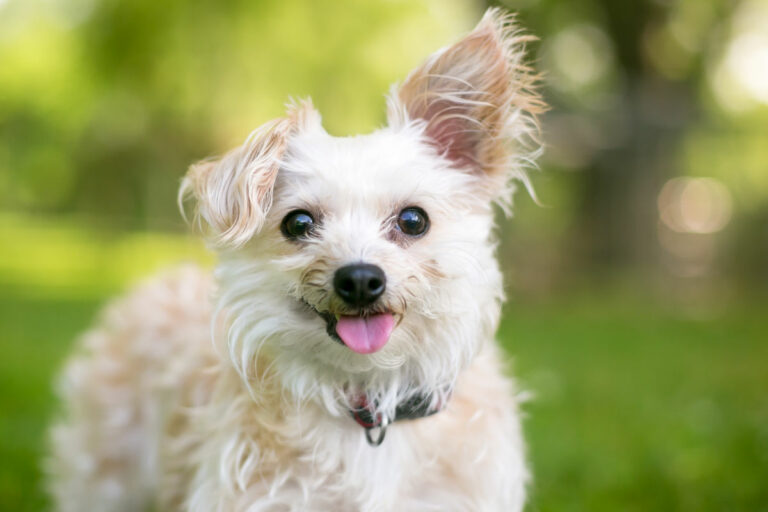Chi Poo Dog breed Information: Chihuahua Poodle Mix (Chi-Poo / Chipoo)
Although the American Kennel Club doesn’t recognize them due to their mixed heritage, Chi-Poos are appreciated for their low-shedding coats, which may be a plus for those with allergies. Owning a Chi-Poo means you’ll be getting a loving and energetic companion, but it’s also vital to be aware of and address any health issues they could inherit from their parent breeds.
Regular grooming is necessary to keep their coat in good condition.
Key Takeaways
- Chi-Poos blend Chihuahua bravery with Poodle intelligence.
- Ideal for apartment living, these dogs are small and joyful.
- They require regular grooming to maintain their low-shedding coat.
Quick Facts
The Chi-Poo is a hybrid breed created from a mix of Chihuahuas and Poodles. These dogs are recognized for their compact size, usually weighing five to 20 pounds and standing five to 15 inches tall at the shoulder. They’ve become famous for blending the small stature of Chihuahuas with the Poodles’ low-shedding coat.
Chi-Poos are playful and intelligent, thanks to the characteristics they inherit from their parent breeds. They are small but full of energy and can handle being alone for some time, making them versatile companions for different occasions.
Chi Poo Pictures
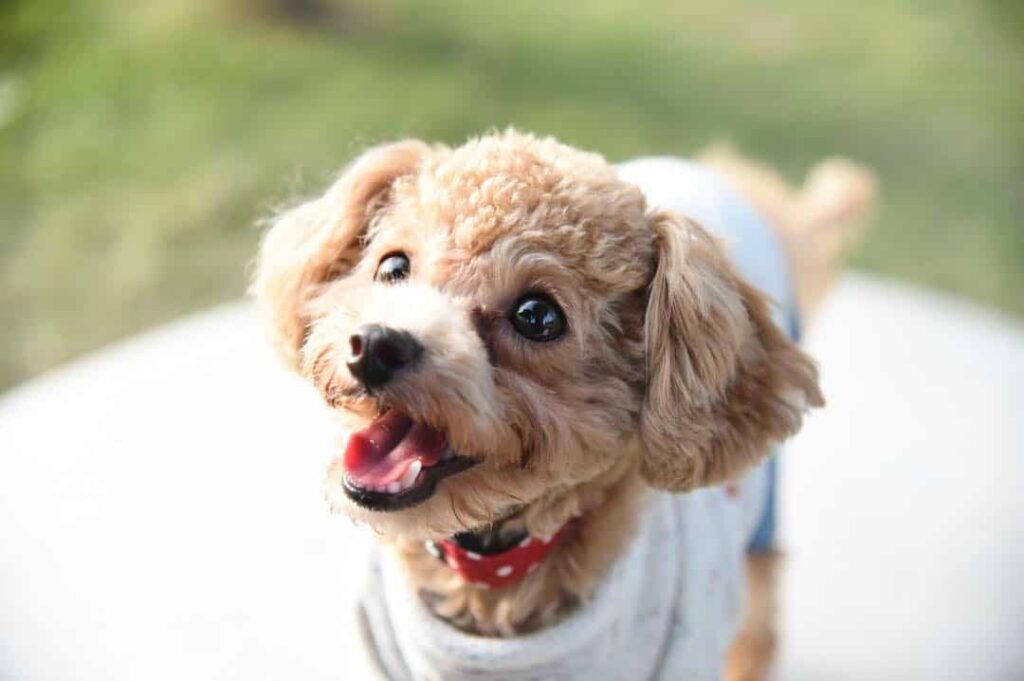
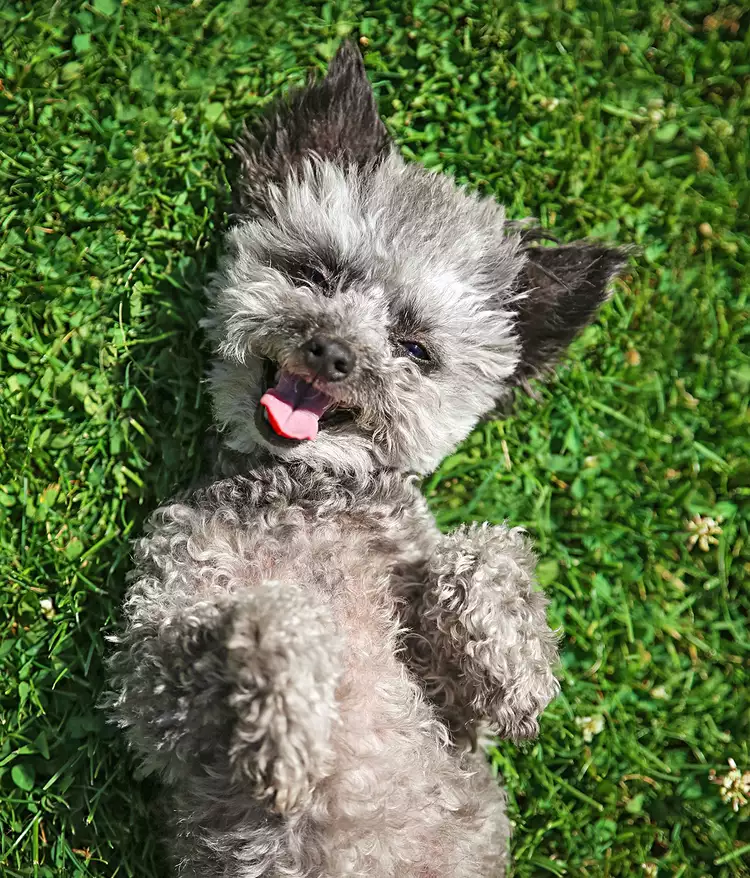
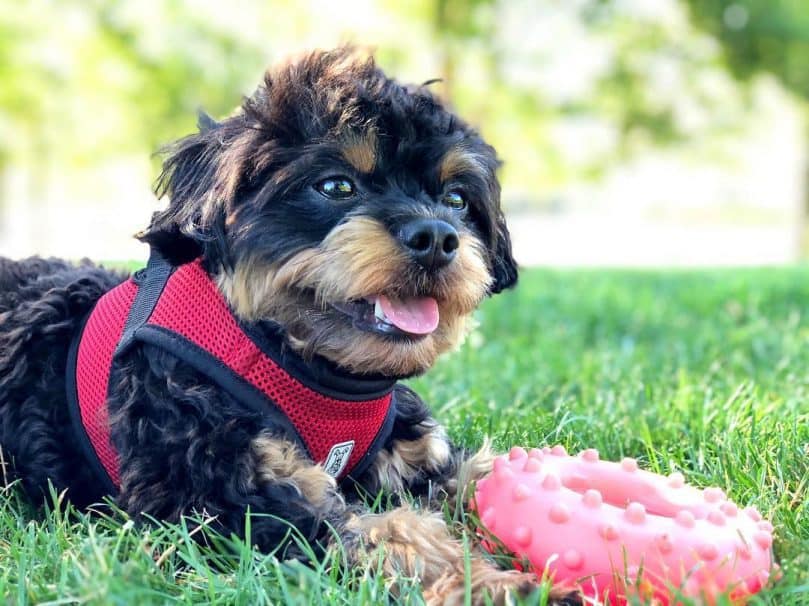
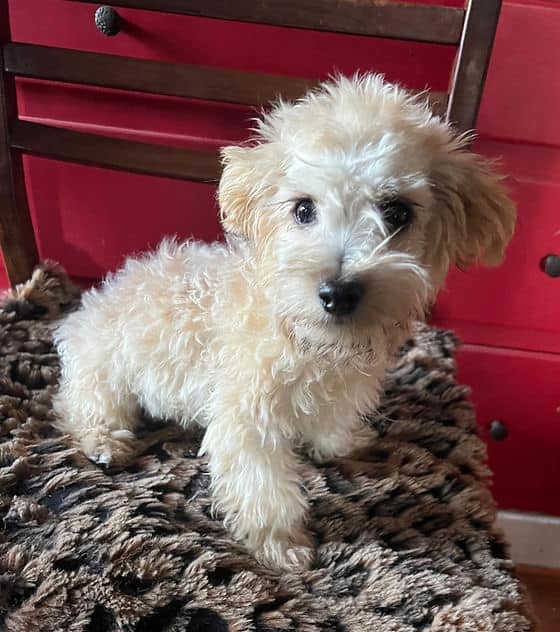
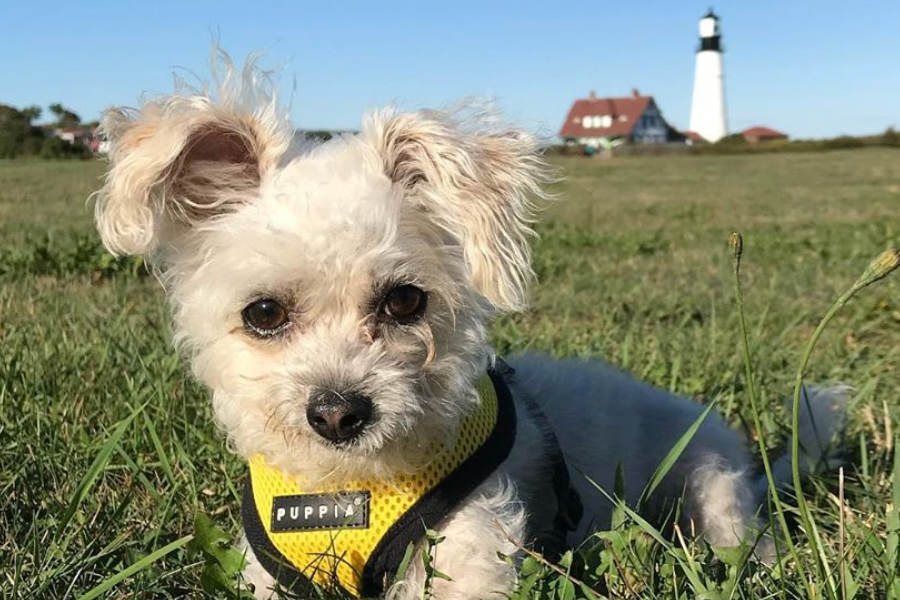
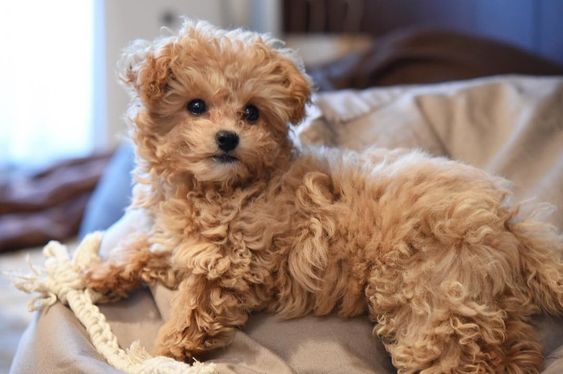
Overview
The Chi Poo’s charm lies in its versatility, blending the small size of the Chihuahua with the Poodle’s allergy-friendly coat. This makes for a pet that’s energetic and easy to handle for different owners.
Known as a mix between Chihuahua and Poodle, the Chi Poo combines qualities from both its parents. This small dog fits well in various living spaces, whether large houses or apartments.
People often choose Chi Poos for their manageable grooming needs and the lively yet loving personality they offer. They fit in with the fast-paced modern lifestyle, requiring moderate exercise that matches well with active owners who don’t have the time for long workout sessions with their pets.
Key Traits
Chi Poos are known for their intelligence, playfulness, and independence, inherited traits from their Chihuahua and Poodle parents. These characteristics make Chi Poos stand out to dog lovers and make it easy for trainers to work with. Their innovative nature means they quickly pick up on new commands, mainly when trainers use praise and treats as motivation.
Here’s a summary of the Chi Poo’s main qualities:
| Trait | Description | Resulting Benefit |
|---|---|---|
| Intelligence | Quick learners and problem solvers | Responds well to training using positive methods |
| Playfulness | Lively and full of energy | Great companions for people with an active lifestyle |
| Independence | Capable of being content when alone | Adapts well to different home environments |
Understanding these traits helps potential owners see why Chi Poos are versatile companions, highlighting the need for engaging activities and consistent training. These dogs do well with owners who provide a lively environment and transparent, consistent training practices.
Breed Origins
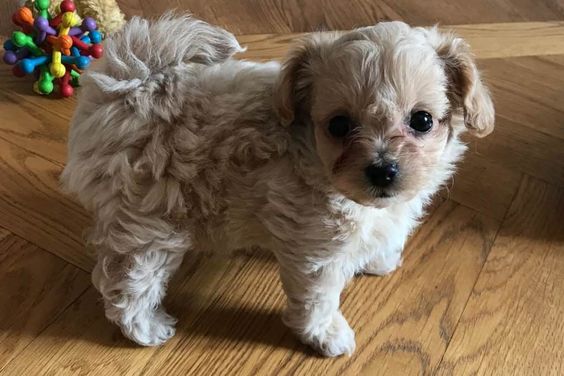
The creation of the Chi Poo, a mix between a Chihuahua and a Poodle, is a recent development in the world of dog breeding. This intentional mix aims to blend the best qualities of both breeds. As the Chi Poo has gained popularity, discussions have sparked around the idea of hybrid vigor. This concept suggests that crossbred dogs like the Chi Poo may have better health due to their mixed genetic heritage.
The Chi Poo has American roots, although the Chihuahua and the Poodle come from very different parts of the world. This diverse background gives the Chi Poo a range of desirable traits from both lines. Understanding the history of the Chihuahua and the Poodle helps explain why the Chi Poo has particular looks and behaviors. These insights into the breed’s past help owners appreciate the unique qualities of their pets today.
Parent Breeds History
Chihuahuas have a long history that stretches back to ancient Mexico, where they were highly valued, possibly even worshipped. They are thought to have evolved from the Techichi, a small dog that was a favored companion in the Toltec civilization, and later with the Aztecs, who used them in rituals and as pets.
Poodles, known for their skills in retrieving waterfowl, originated in Europe. They are descended from various European water dogs like the Barbet and became known for their sharp minds and easy trainability, which made them stars in circus shows.
When you mix the Chihuahua and the Poodle, you get the Chi-Poo, a designer breed acknowledged by the American Canine Hybrid Club. This hybrid dog combines the tiny size and loyal nature of the Chihuahua and the Poodle’s intelligence and allergy-friendly coat.
Hybrid Vigor Debate
Hybrid vigor is often mentioned as a benefit of the Chi-Poo breed, suggesting that these dogs may enjoy better health and more energy because of their mixed heritage. The idea is that by combining species, the genetic diversity could lower the chances of the dogs inheriting specific health issues seen in purebred Chihuahuas and Poodles.
However, hybrid vigor isn’t a sure thing for every individual dog. Some Chi-Poos can be in excellent health, while others might still face the same health challenges that affect their purebred parents. Good breeding practices, including comprehensive health checks and introducing puppies to various early experiences, are vital in reducing health risks and ensuring the dogs lead happy, healthy lives.
Originating Countries
The Chi-Poo is a charming mix, born in the United States from the union of the Chihuahua and the Toy Poodle. The Chihuahua hails from Mexico and was recognized in the 19th century, while the Poodle, known for its smarts and low-shedding coat, originates in Germany and France.
This breed blend was purposefully created to produce a small, lively companion dog that combines the best features of its parents. The Poodle was once a prized water retriever and later became a favorite of French nobility, while the Chihuahua has a storied past in Mexico.
The creation of the Chi-Poo in the U.S. aimed to offer dog lovers a pet with both the Chihuahua’s vivacity and the Poodle’s intelligence.
Physical Dimensions
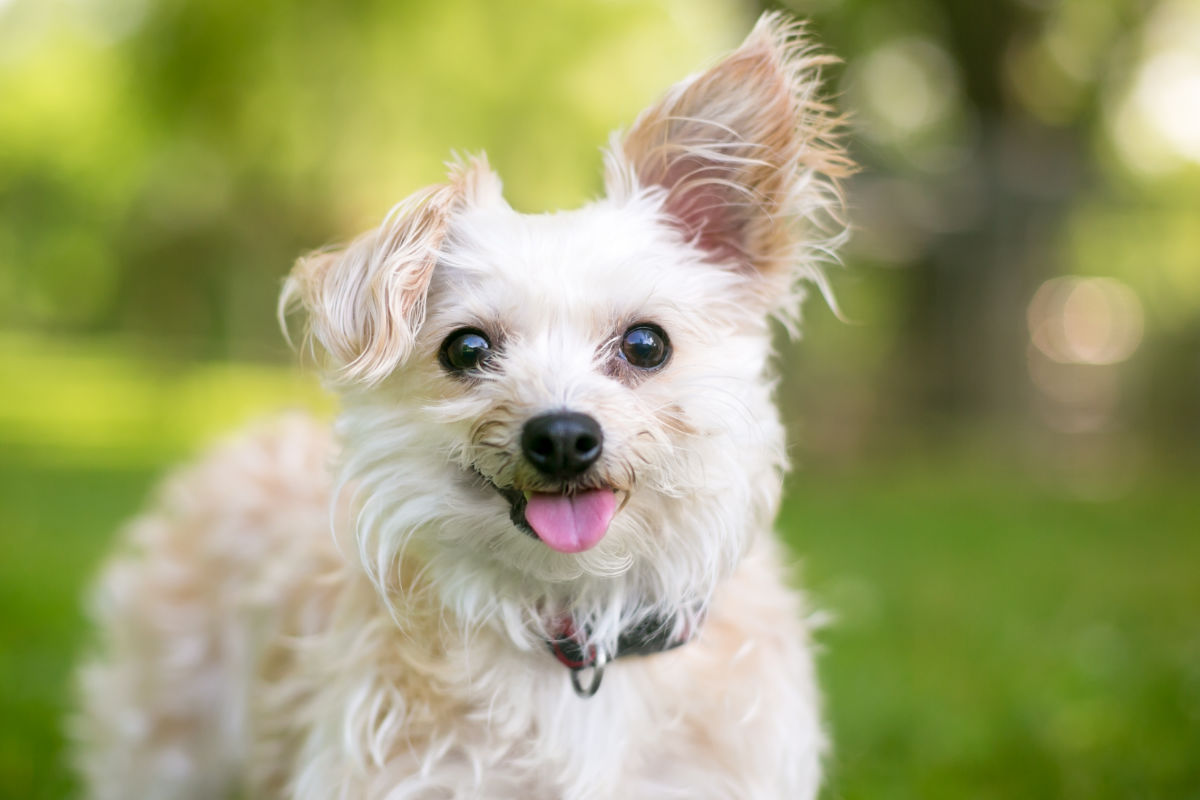
The Chi Poo is a charming mixed-breed resulting from a Chihuahua and Poodle mix. This blend leads to a variety of sizes and weights. These dogs can stand anywhere from 5 to 15 inches tall at the shoulder. Their importance can fall between 5 and 20 pounds, depending on their diet and genetic background.
Growth patterns in Chi Poos can be unpredictable due to the mixing of genes from their distinct parent breeds. Each Chi Poo may display a unique combination of traits affecting their build and look. This diversity means that their physical characteristics can significantly vary from one dog to another.
Understanding these traits helps potential owners determine how well a Chi Poo might fit into their home and lifestyle.
Average Height, Weight
Chi Poos are a crossbreed between Chihuahuas and Toy Poodles, with a weight ranging from five to 20 pounds and a height between five to 15 inches at the shoulder. These miniature dogs are perfect for city living due to their manageable size.
The influence of their Chihuahua and Poodle heritage is apparent in the Chi Poo’s slight build. Keeping an eye on their weight is critical to avoid injuries and to keep them healthy and happy.
Growth Patterns
Knowing how your Chi Poo grows helps you plan for their development. In the early weeks, these puppies proliferate, gaining weight and height. As they get older, usually by several months, their growth slows down, and they stop getting bigger once they’re fully grown.
Since Chi Poos are generally small, watching their growth is essential to ensure they’re on the right track. Regular exercise is vital to keeping their weight in check and building strong muscles, especially since they’re energetic and active.
It’s also essential to keep their small size in mind to prevent injuries during their formative months.
Size Variability
Chi-Poos can range in size quite a bit, even though they come from smaller breeds like the Chihuahua and Toy Poodle. Their weight can be anywhere from 5 to 20 pounds, and their height at the shoulder can vary from 5 to 15 inches. This variation is expected in mixed breeds due to the different genes they inherit from each parent.
The size of a Chi-Poo can influence how well they fit into different living spaces and their risk of injury. Despite such differences, the American Canine Hybrid Club and Designer Dogs Kennel Club have recognized Chi-Poos, which shows that fans of small breeds appreciate their variety.
Breed-Specific Proportions
Chi Poos are charming hybrids with a mix of features from their Chihuahua and Toy Poodle ancestors. They’re small and adaptable, fitting well in cozy homes or apartments. Due to their compact size, they must go outside often, especially for potty breaks. Consistent house training is vital in helping them learn where and when to relieve themselves.
Their heritage may include the Chihuahua’s tendency for watery eyes, which can cause stains on their medium-length fur. These little dogs also have a higher risk of dental problems because of their petite mouths, so keeping up with their dental hygiene is necessary.
Despite the lack of official recognition by the American Kennel Club, Chi Poos have become popular pets, especially for their allergy-friendly coats and ability to thrive in smaller spaces.
Physical Build Traits
The Chi Poo stands between five and 15 inches tall and weighs somewhere from five to 20 pounds, a blend of the Chihuahua’s small stature and the Toy Poodle’s robust but compact frame. Perfect for people living in apartments, this breed doesn’t need much room and offers good company.
The coat of the Chi Poo varies widely in color and texture, showing off the rich diversity of its Chihuahua and Poodle heritage, with options ranging from smooth to curly and plain to patterned. Another charming feature is its fluffy tail which gives the Chi Poo a unique outline.
This breed is known for being low-maintenance in grooming because of its hypoallergenic coat that helps reduce shedding – great news for keeping the house clean and for anyone with allergies.
Behavioral Traits
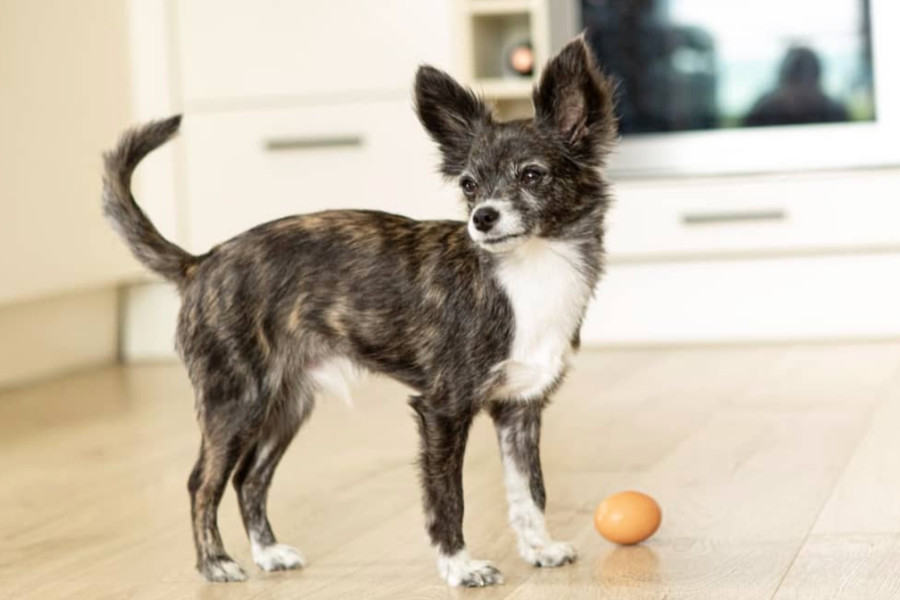
Understanding Chi Poos’s behavior is crucial for a peaceful home with these pets. Owners need to be aware of the nuances in their behavior to provide the best care.
Training Approach:
Chi Poos are intelligent and need engaging training sessions to keep their minds sharp and encourage obedience.
Social Interaction:
Introducing them to different people and animals early on can prevent future anxiety or hostility.
The personality of a Chi Poo can differ significantly, often based on their genes and early life experiences. This means owners should have personalized strategies for managing their behavior.
Lastly, these dogs might have a strong instinct to chase, so teaching them how to behave around smaller creatures is wise.
Training Challenges
Training a Chipoo can be quite a task because they are intelligent and have their minds, requiring owners to be consistent and patient. These dogs understand new ideas quickly but might resist during potty training and obedience drills due to their stubborn nature.
Their abundant energy demands engaging training sessions to keep them busy and out of trouble. Positive reinforcement works well with Chipoos, as they respond to rewards and praise. However, owners need to be firm and kind during training to manage their assertive nature and to position themselves as the pack leader for practical training.
Socialization Requirements
Socializing a Chi Poo is critical to its growth. These intelligent dogs must adapt confidently from structured training to everyday social situations. It’s about getting the Chi Poo comfortable in various settings, such as the dog park, where it learns to play with other dogs.
Regular exposure to new places and people helps Chi Poos become adaptable and friendly, even with kids, when they learn clear limits. Watching how they behave and addressing any issues promptly is essential.
A combination of mental challenges and exercise also helps to keep their barking at strangers in check, leading to a well-rounded and friendly companion.
Temperament Variability
Chi Poo dogs exhibit a range of behaviors, from being watchful and sharp to playful and loving, due to their Chihuahua and Poodle heritage.
These hybrid dogs may show a Poodle’s combined intelligence and playful nature with the steadfast loyalty and alertness of a Chihuahua. Such a mix leads to a pet that can adjust well to different home environments and is open to training that encourages good behavior.
While naturally inclined to be lively, they also have an independent side that benefits from regular interaction with people and other dogs.
For Chi Poo owners, recognizing the various aspects of their dog’s personality is critical to providing the proper care that supports both their physical health and emotional needs.
Prey Drive Management
Chi Poos, a mix of Chihuahua and Poodle, may have a strong instinct to chase, which owners should manage through steady training and social encounters. Understanding this behavioral tendency is critical to applying the right strategies for guidance.
A consistent physical activity routine is crucial because it uses the energy that could lead to chasing behaviors. Training sessions focusing on commands to shift the dog’s attention and improve self-control are fundamental in adjusting their instincts.
Involving the Chi Poo in activities that redirect their energy towards positive outlets is an effective way to manage their prey drive. Introducing them to different dogs and environments is also essential, as it helps them become more adaptable and less likely to give in to chasing urges. This way, they grow into well-behaved pets.
Handling Aggression Issues
Chi Poos are known for their lively personalities, but sometimes this can lead to aggressive behaviors. Structured behavior training is vital to promote peaceful interactions with people and other pets. All dogs, including Chi Poos, can act aggressively in certain situations. They deal with these issues through expert and consistent training and shape well-behaved companions.
Owners should use positive reinforcement and set clear rules to teach their dogs good manners. They should also ensure their pets get plenty of social interaction. Understanding what triggers a dog’s aggression and managing those situations can prevent problems. Such careful training and early socialization benefits not only the dog’s temperament but also its overall happiness.
These steps help Chi Poos become loving and friendly members of any household.
Health Concerns & Management
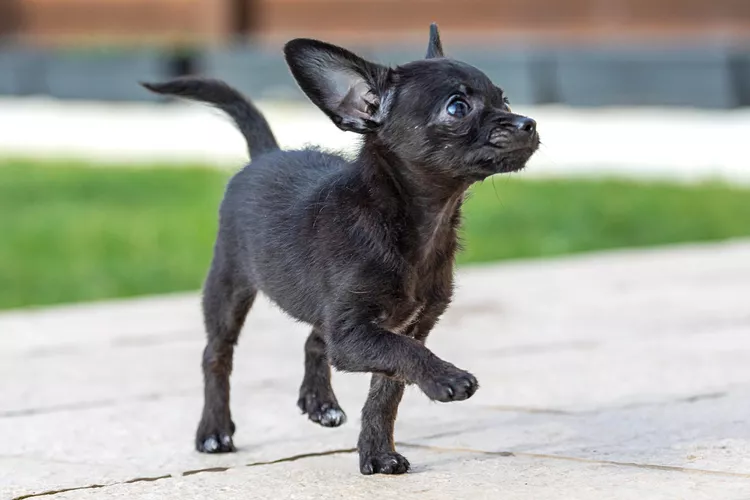
Owning a Chi Poo means being proactive about their health. These dogs inherit specific health risks from their Chihuahua and Poodle parents, so preventive care is critical. Staying ahead of health issues can lead to your pet’s longer, happier life.
Awareness of their genetic risks, like low blood sugar and knee issues, is the starting point. A solid health plan can help prevent these issues from developing. Catching signs of common conditions such as eye pressure problems or tooth decay early is vital.
And don’t forget, a healthy diet and regular exercise are fundamental to keeping your Chi Poo in top shape.
Genetic Health Risks
Chi-Poos, the charming mix of Chihuahua and Poodle, may inherit a few health issues from their parent breeds. Conditions like excessive tearing, low blood sugar, eye pressure problems, and knee joint dislocations are more common in these dogs.
Regular vet visits for early detection and management of these issues are crucial to keeping a Chi-Poo healthy. Owners should thoroughly choose a healthy Chi-Poo and maintain a care routine that includes proper diet and teeth cleaning.
Knowing Chi-Poos’ sensitivity to hot and cold temperatures helps prevent health problems and ensures their happiness and comfort.
Preventive Care Importance
Preventive care is critical to keeping your Chi-Poo healthy and happy for years. Owners should look for signs of inherited health issues, such as low blood sugar and knee problems, often seen in the breed’s ancestors. Regular visits to the vet can catch these problems early, making them easier to treat, while a nutritious diet helps keep their coat shiny and supports their overall health.
Good dental care and the right amount of food are essential to prevent dental and weight-related issues. When choosing a Chi-Poo, selecting one from a trusted breeder is wise to ensure they have a solid genetic background.
Common Illnesses Identification
Chi-Poo owners need to pay close attention to signs of common health problems, such as breathing difficulties, to get treatment quickly. Since Chi-Poos are a mix, they might be prone to the health issues affecting Chihuahuas and Poodles.
When they shed a lot, the extra hair could lead to skin problems and blockages in their digestive system if they swallow it. Regular brushing can help prevent these problems. Paying careful attention to their diet and nutrition can help avoid low blood sugar levels, which is especially risky for small dogs like the Chi-Poo.
Regular visits to the vet are crucial to catch and treat inherited problems early, like knee issues or eye conditions, keeping your dog healthy.
Owners should be proactive with their Chi-Poo’s health, watching for early signs of trouble and keeping up with regular health checks. This approach enables them to manage their furry companion’s well-being effectively.
Grooming and Maintenance
Proper grooming and maintenance are vital for a Chi Poo’s health and good looks. Understanding the specific grooming needs of this mixed breed helps you keep your pet happy.
Regular brushing at least once a week is essential to reduce hair loss and avoid tangles.
It’s also wise to have a consistent bathing routine to keep your Chi Poo’s coat fresh while preserving its natural oils.
Nail trimming every two weeks is essential for your Chi Poo’s comfort and to prevent issues with walking.
Don’t forget about ear care—clean them frequently to prevent infections and ensure your dog doesn’t suffer from hearing problems.
Following these steps will help maintain your Chi Poo’s well-being and allow them to look their best.
Coat Brushing Frequency
Brushing your Chi-Poo’s coat once a week with a bristle brush helps keep shedding under control and is suitable for people with allergies. If your Chi-Poo has skin like a shorthaired Chihuahua, you might need to brush it more often to spread the dog’s natural oils, which keeps their skin healthy and shiny.
Regular grooming strengthens your bond with your pet and helps you spot any skin problems early on. Using dry dog shampoo during grooming can keep your Chi-Poo’s coat fresh while avoiding too many baths, which can remove essential oils from their fur.
Keeping up with your Chi-Poo’s coat care prevents knots and ensures your dog stays comfortable and happy.
Bathing Schedule Tips
When it comes to grooming, a Chi-Poo benefits from a bath every two months, or sometimes more if they love getting dirty while playing outside. Maintaining a regular bathing schedule is critical to promoting healthy skin and coats. If your Chi-Poo is quite active, a monthly bath might be enough, but remember that too many baths can remove essential oils and lead to skin problems.
Always use a mild shampoo made for dogs and rinse your pet well to remove any leftover soap. After the bath, brushing their coat regularly will keep it shiny and prevent tangles. Regular grooming not only keeps your Chi-Poo looking great but also helps to strengthen your bond with your pet.
Nail Clipping Essentials
Keeping a Chi-Poo’s nails trimmed is essential for their comfort and overall health. Overgrown nails can cause problems with their walking and balance due to their small size.
New dog owners often choose Chi-Poos for their compact build and friendly demeanor, but these pups need regular grooming to keep their nails short. Without proper nail care, a Chi-Poo may suffer from pain and even develop long-term joint problems.
Regular and gentle nail trimming helps maintain a Chi-Poo’s active lifestyle and keeps them free from mobility issues.
Ear Cleaning Techniques
Keeping your Chi-Poo’s ears clean prevents infections and promotes overall ear health. For sensitive breeds like the Chi-Poo, cleaning their ears requires careful handling to avoid injuring their delicate inner ear structures.
Experts from the American Kennel Club suggest a systematic approach to ear care. It’s best to check the ears for signs of dirt, redness, or strange smells. Use a cleaner approved by your vet and gently wipe the outer ear canal, taking care not to probe too deeply.
Consistent ear care keeps your dog’s ears clean and helps you spot any health issues early so you can seek professional help if needed.
Shedding Management Strategies
Regular grooming is vital for maintaining the health of your Chi-Poo’s coat and controlling its minimal shedding. These dogs, often with a Chihuahua in their lineage, may have a variety of coat textures that dictate their specific grooming requirements.
To keep their coat in good shape and your home free of hair, it’s advisable to brush them weekly using a bristle brush. Even with their low-shedding coats, don’t ignore their grooming needs, as they could have curls that might need occasional trimming.
Consistent grooming sessions are a chance to check on your dog’s overall well-being, especially to detect any skin issues that might go unnoticed due to their active lifestyle.
Maintaining a regular grooming schedule is essential for these energetic and low-shedding pets.
Dietary Requirements
Chi Poos are a small breed with specific nutritional needs that must be met to keep them healthy and energetic. Choosing the right food is vital to avoid deficiencies and fit their high-energy lifestyle. Owners should be vigilant about food allergies and diet-related health issues, setting a consistent feeding schedule and regularly checking in with a vet for dietary adjustments.
- Choose high-quality food designed for small breeds, rich in nutrients.
- Stay alert for signs of food allergies and manage them proactively.
- Maintain a regular feeding routine to keep their metabolism steady.
- Regular vet check-ups are necessary to fine-tune your Chi Poo’s diet as they grow.
Careful monitoring and adjustments to their food can prevent health problems and keep your Chi Poo thriving for years to come.
Optimal Food Choices
Choosing the right food for a Chi-Poo, especially one designed for small breeds, is vital for their well-being and vitality. These dogs often have sensitive stomachs and need regular, well-balanced meals to prevent low blood sugar.
Opt for a high-quality formula for smaller dogs, including kibble, that’s easy to chew and packed with nutrients. Since Chi-Poos are known for their intelligence and liveliness, their food should help maintain their brain health and boundless energy.
Always choose ingredients that are beneficial for them, like whole proteins, complex carbs, essential fats, and fiber. Please consult a vet to ensure the diet meets your Chi-Poo’s needs and supports their overall health, considering any particular health issues common to the breed.
Allergies and Sensitivities
When considering a Chi-Poo’s diet, we must also know about allergies and sensitivities affecting their health.
The Chi-Poo, recognized by organizations like the International Designer Canine Registry and the Designer Dogs Kennel Club, is often chosen by people with allergies because they don’t shed much. But it’s more than their coat that we need to be attentive to.
These dogs can have food allergies or sensitivities that demand careful monitoring and diet adjustments. Scheduling regular vet visits is a proactive way to catch these issues early. Since a Chi-Poo is often considered a beloved companion, their well-being is a priority, which means being thoughtful about what we feed them to prevent health problems.
Feeding Schedule Importance
A consistent feeding schedule is vital for Chi-Poo’s health. These small dogs need specific nutrition that prevents digestive problems and protects them from low blood sugar levels.
Owners should follow the American Kennel Club’s advice to give balanced meals in the right amounts based on the dog’s age, size, and activity. This approach helps maintain a healthy weight and reduces the chance of obesity-related diseases.
It’s also essential to have regular vet check-ups to adjust the diet as the dog grows and changes.

